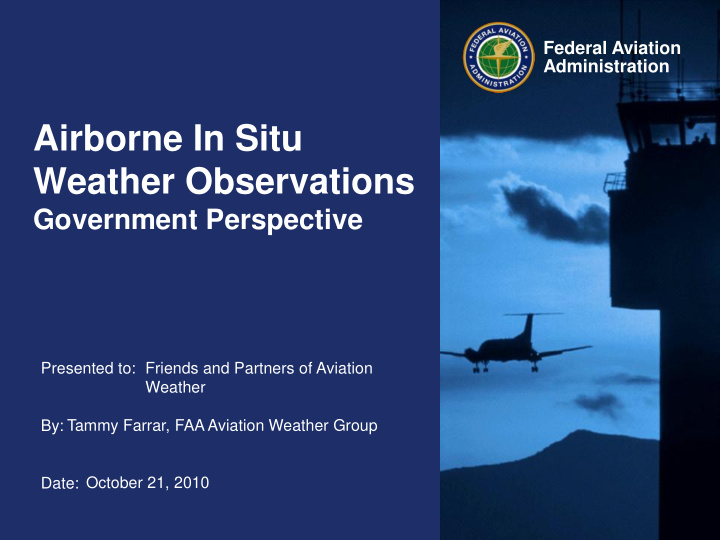



Federal Aviation Administration Airborne In Situ Weather Observations Government Perspective Presented to: Friends and Partners of Aviation Weather Tammy Farrar, FAA Aviation Weather Group By: Date: October 21, 2010
Airborne In Situ Weather Observations Government Perspective • Current Status – MDCRS Contract – Eddy Dissipation Rate (EDR) – Graphical Turbulence Guidance (GTG) – Future Efforts • Optimization – Right-sizing Program – Airborne Obs Component – Need for interagency/industry-level agreements Airborne In Situ Weather Observations Federal Aviation 2 2 October 21, 2010 Administration
Airborne In Situ Weather Observations MDCRS Contract Update • Current contract with ARINC expires Mar 31, 2011. • Market survey currently out on FAA Business Opportunities website – https://faaco.faa.gov/ Airborne In Situ Weather Observations Federal Aviation 3 3 October 21, 2010 Administration
Airborne In Situ Weather Observations Eddy Dissipation Rate (EDR) • Current Deployments – DAL ~80 737NGs – UAL ~100 757s – SWA 10 737s (FY10) • FY11 – Continue SWA deployments – Begin deployment DAL and UAL 767s • Transoceanic coverage Airborne In Situ Weather Observations Federal Aviation 4 4 October 21, 2010 Administration
Average 24 hour EDR coverage UAL ~100 a/c SWA 10 a/c DAL ~80 a/c Airborne In Situ Weather Observations Federal Aviation 5 5 October 21, 2010 Administration
Airborne In Situ Weather Observations GTG2 Implementation GTG GTG2 • GTG2 incorporates EDR observations • GTG2 implemented operationally at AWC 1Qtr 2010 Airborne In Situ Weather Observations Federal Aviation 6 6 October 21, 2010 Administration
Projected GTG releases – next 7 years Version Capabilities Op. date*/enter NWEC GTG1Upper levels 3/2003* RUC20 GTG2Improved GTG1 2/11/2010* +Mid levels GTG6 +Uses UAL in situ GTG2.5 13 km WRF RR 1/1/2011 Mid levels +VWA insitu GTG5 GTG1 GTG313 km WRF RR 3/31/2012 +MWT Seg 1 versions Optimized use of insitu GTG3 1-12 hrs GTGN1 NTDA2/DCIT/insitu 6/30/2012 GTG2 GTG3 GTG5 mid+upper levels, 0-15 min GTG4Improved GTG3 FY15 Ensembles/Probabilistic forecasts GTG4 all altitudes, full WRFRR domain GTGN2 NTDA3 FY15 GTG4 NextGen IOC versions 0-FL450, 0-1 hr Global GTG Global – GFS based FY15 Source: P. Lester, “Turbulence – A GTG5Improved GTG4 FY17 CIT/HRRR new perspective for pilots,” GTG6Improved GTG5 FY19 Jeppesen, 1994 < FL650 Airborne In Situ Weather Observations Federal Aviation 7 7 October 21, 2010 Administration
Airborne In Situ Weather Observations Future Efforts • Future EDR Deployments – “When is enough, enough?” – NAS cost-benefit needed for possible future government buy-ins – DAL EDR Proof of Concept Demo • Attempting to document benefits to NAS capacity and flight operations • Data collect on-going, thru mid-January 2011 Airborne In Situ Weather Observations Federal Aviation 8 8 October 21, 2010 Administration
Airborne In Situ Weather Observations Future Efforts • MCR on contract for EDR NAS cost-benefits study – Purpose: • To determine delays due to Clear Air and Convectively Induced Turbulence • To quantify the amount of avoidable turbulence delays that EDR could be expected to mitigate – Preliminary results available in FY11 Airborne In Situ Weather Observations Federal Aviation 9 9 October 21, 2010 Administration
Airborne In Situ Weather Observations Optimization Spatial Coverage SFC-FL150 FL150-400 Temporal Coverage • The selection of specific aircraft to obtain the data required to meet the government’s forecasting needs while reducing redundant or unnecessary observations that increase communications and processing costs. Airborne In Situ Weather Observations Federal Aviation 10 10 October 21, 2010 Administration
Airborne In Situ Weather Observations Optimization • FAA Right-sizing Program: Airborne Obs Component – Baseline of current airborne sensor capabilities near complete – Concept of Operations in development – Requirements analysis underway – Gap identification (Super Density Terminal Ops) FY11 – Gap Identification (En Route) FY11-12 – Mitigation strategy development/demos FY12 Airborne In Situ Weather Observations Federal Aviation 11 11 October 21, 2010 Administration
Airborne In Situ Weather Observations Optimization • Cooperative strategy development – FY11 – Governmental interagency agreements – FY12 – Government/Industry interagency agreements • Cost responsibilities? • Data access? Airborne In Situ Weather Observations Federal Aviation 12 12 October 21, 2010 Administration
Airborne In Situ Weather Observations Summary • FY10: – SWA EDR deployments begun – GTG2 implemented operationally – DAL EDR Demo On-going • FY11: – Begin DAL/UAL 767 EDR deployments – Optimization – Right-sizing Activities – Conclude DAL EDR Demo and Cost Benefits Analysis • Future (FY11/12 ): – Optimization – Cost and data sharing policy/agreements development Airborne In Situ Weather Observations Federal Aviation 13 13 October 21, 2010 Administration
• Back Up Slides Airborne In Situ Weather Observations Federal Aviation 14 14 October 21, 2010 Administration
Airborne In Situ Weather Observations Terminology • AMDAR – Aircraft Meteorological DAta and Relay: A WMO- sanctioned international program of nations with air carriers that provide automated weather observations. • MDCRS – Meteorological Data Collection and Reporting System: US analog of AMDAR, a private/public partnership. • ACARS - Aircraft Communications, Addressing, and Reporting System: The name of a datalink service provided by Aeronautical Radio, Inc. (ARINC) that sends information between aircraft and ground stations. • TAMDAR - Tropospheric Airborne Meteorological DAta Reporting: “AirDat's network of patented airborne sensors…which provide a continuous stream of real time observations….”. (http://www.airdat.com/./index.php) Airborne In Situ Weather Observations Federal Aviation 15 15 October 21, 2010 Administration
Recommend
More recommend